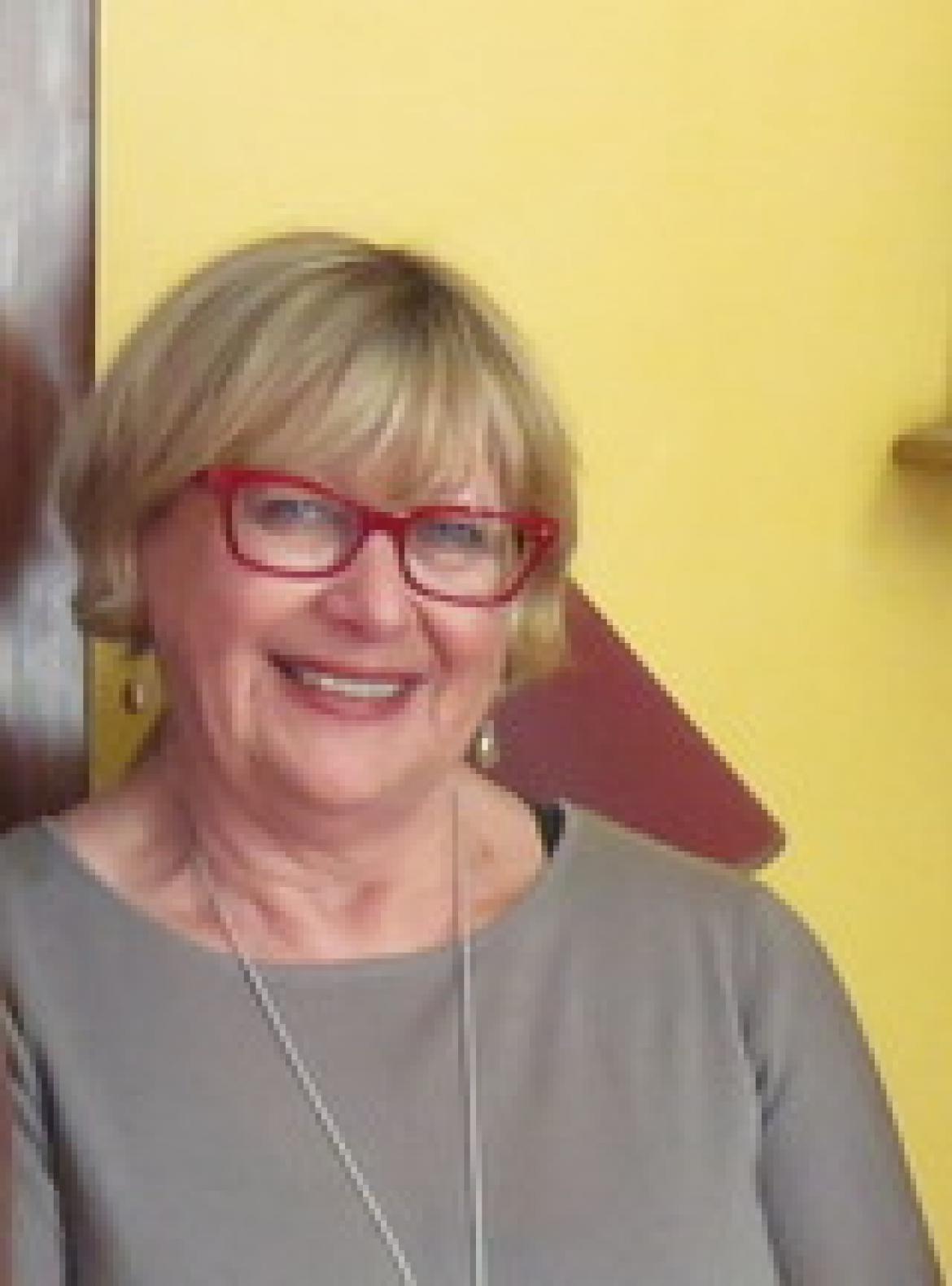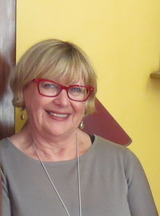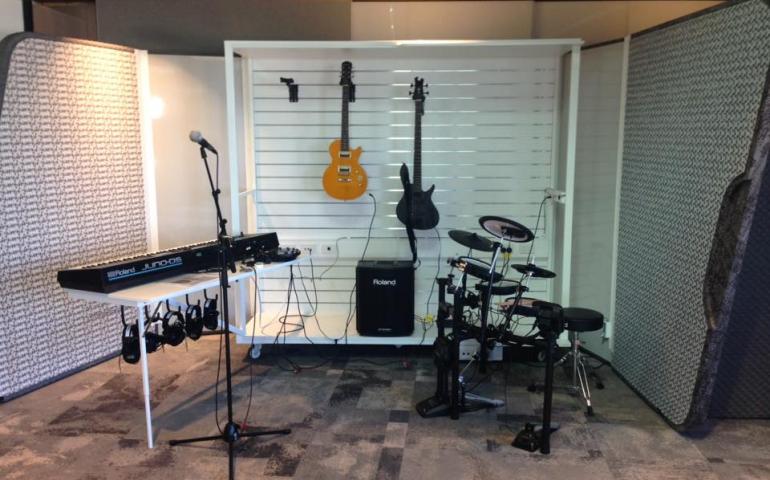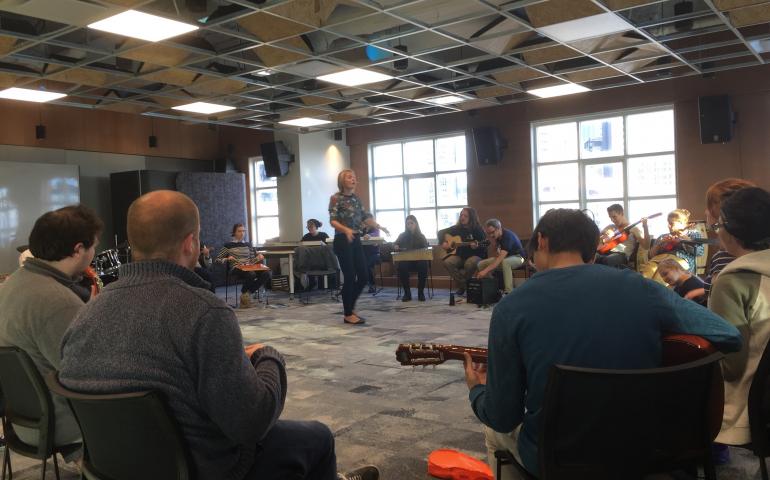My Music Education Life is an opportunity for members to share, in their own words, a flavour of their professional world. If you wish to submit an article for this section of the ISME newsletter please email to Sara Hood.
This month My Music Education Life is from Associate Professor Neryl Jeanneret, Associate Dean, Research Training and Head of Music Education in Arts Education in the Melbourne Graduate School of Education, University of Melbourne, Australia.
She has also been a commission chair for ISME and chair of ASME (Australian Society for Music Education).
These musings are a light-hearted look at the spaces in which we try to teach classroom music via an abridged history of my experiences.
My first music classroom, as a newly minted teacher, looked the same as the one I had spent six years in as a high school student. It was typical of the 1960s and 70s in New South Wales, as was the design of the school. Concrete and brick “donuts” with a courtyard at the centre and two floors of classrooms around it. The block where you found Music was “suitably” housed with Home Economics, Art, Woodwork and Metalwork. There were a few problems with this concept. As a student, any listening was abandoned when the bandsaw fired up next door. As a teacher, it was being confronted by a red-faced Home Economics teacher who was trying to initiate a class into to the fine tunings of soufflés with the 1812 Overture (and real cannons) pounding through the ceiling.
These music rooms were very uninviting. Exposed brick walls, lots of tables and chairs, a teacher’s desk, linoleum on the floors, an upright piano, maybe a store room if you were lucky, and perhaps some storage cupboards at the back. I always thought it was a mad way to design music classrooms. You wouldn’t sit bolt upright at the kitchen table at home when settling down to listen to your favourite music or knock out a few chords on the guitar. And there was little space left when you filled the room with 30 children and their bags. How on earth could you do anything practical in this arrangement? The first thing I did was paint the bricks that bore some none too flattering graffiti directed at my predecessor. “Why are some bricks painted, Miss? Because I felt like it” …smile enigmatically. Then I experimented with organising the tables and chairs. Rows, two horseshoes, one horseshoe, groups of tables, and so on. Nothing was especially successful but at least the horseshoe meant I could move around the students a bit more easily as long as I didn’t trip over the bags.
And remember, this was in the days of chalkboards. Everything, and I mean everything, was covered with chalk dust. The teacher’s desk and anything on it, the sound system, records (yes, we’re pre-CDs at the moment), the instruments, and my nostrils, which was an endless source of irritation. Then whiteboards were invented and a very cunning music inspector announced to the powers that be that all music rooms in state schools should be issued with such immediately in the interests of preserving the valuable sound equipment that had been a considerable investment. Good-bye chalk dust for the time being until I went to work in the university system.
At that point, the sound systems were relatively quite good. I presume because of the same music inspector’s efforts in the past. We did have a small problem with where you actually put the speakers. Expending some effort to mount them on the walls appropriately seemed inexplicable to the school executive until the incident. My colleague complained her sound system was not working and we tried everything but to no avail. We finally took the front covers off the speakers and the problem was obvious – there was nothing inside. Some enterprising child had removed everything and managed to make off with the spoils without anyone noticing. A mystery, given at that time the music rooms were only accessible with supervision, but I have some enduring doubts about my colleague’s powers of observation. The next week the speakers were mounted on the walls of both music rooms.
The classroom instrumental resources were limited. My senior teacher kindly demonstrated how to do “practical” lessons with a view to me emulating the procedure. Students were issued with a single chime bar and shown when to play as their chord came around. With very simple repertoire, it wasn’t much fun if you had the root or the third of chord IV. Over time, I built up a supply of melodic percussion, which made practical lessons a bit more meaningful but had my art colleagues screaming for mercy in the staffroom next door after a day of Year 8 on the glockenspiels. We finally acquired a class set of guitars, and while you could manage the melodic percussion on a configuration of desks, 30 children with guitars, chairs and desks was a nightmare.
Move 20 years on. I am now newly appointed to the University of Melbourne in 2005 and those early years of teaching come flooding back. Refurbishment of the music and drama spaces has been promised for some time but is still two years away. The music room is underground in a heritage-listed Art Deco building and I love that, but the configuration of the small spaces is less than ideal. There is no data projection facility or screen, which requires me to bring the data projector trolley in the elevator from the fifth floor. Once we have the trolley in the room, a portable screen, the sound system hooked up with additional cables that would send the OH&S officer into a spasm, 30 adults and me, it’s best described as very cosy. Organising practical music making required military type planning and strategies but we managed in the end. Music teachers always do. One win in those early days was to eliminate the need for the portable screen by painting one of the walls white. The painters arrived during a class one afternoon, apologised and promised to come back at another time. Both the students and I begged them to do the job then and there, despite gasping with the fumes in the underground. Getting rid of the screen meant less manoeuvring.
The refurbishment negotiations were almost akin to something you would imagine happening in the UN. Many meetings and much toing and froing as both the music and drama staff attempted to convey their special needs and explain why the specifications for either a “normal” teaching space, or drama and music spaces used in other parts of the university didn’t quite match the needs of music and drama education. The result was much, much better than what existed before but we still couldn’t use the space as we had dreamed. The chairs were so heavy it nearly became another OH&S issue to move them, so reshaping the space quickly was a problem; the instruments weren’t easily accessible; you could only view projections in one seating arrangement; the “state of the art” surround sound only worked with DVDs, not CDs, and generally, the quality of the sound was an ongoing issue.
Move 10 years on. The School of Education has now moved to new spaces a brisk 10 minute walk down the hill from the main campus, but the creation of the arts education spaces remained on hold for a number of years. And so we took a deep breath as we began Round Two of negotiations with architects et al about the design of the music space. The first thing we were asked is “how do you teach?” and we were presented with a number of classic university classroom plans – this was a change. But they actually listened when we said, “we can use all these arrangements and then some, in the space of two hours of teaching depending on what we’re doing”. They also acknowledged that we were about arts education with specialist needs, and not a mini version of a music conservatorium or an art school. I was adamant that I wanted a large, open space with no chairs or clutter, and with every possible resource on wheels of some sort so we were completely free to do what we wanted, when we wanted, and without any constraints… and they listened. I admit I’m bordering on OCD when it comes to sound quality and acoustics, but they listened (eventually). Significant soundproofing was also installed after many warnings that music and drama had been happily making as much of a racket as we liked while ensconced in the dungeon up the hill without any impact on other teaching spaces, and we were not about to change. There were other issues (as there are with my renovated kitchen) and 12 months post occupation, they’re still not all resolved, but every day I walk into that space to teach, I’m excited to be able to do exactly what I want to do without compromise… and with natural light. A teacher recently asked me how long it took to get this space. “40 years”, I replied.
I congratulate all those resilient teachers and students across the globe who make the very best of what they have. We’ve all been there in one way or another, and we all know of appalling teaching conditions presented to music teachers that would never happen in other practical-based disciplines. I acknowledge the privilege I have working in Australia and the luxury of being asked what I wanted. At the same time, there was very little to be gleaned from an international search to support my claims to the architects et al (which were “only” grounded in experience), about what music educators need in a classroom. Classroom music education is constantly faced with much bigger and important issues than the room in which we teach, but can I make a small call for some documented “evidence” of the ideal music education spaces to fill the gap?
For images of our space in action, go to our Facebook page, Music Education at Melbourne , officially opened May, 2016.
















